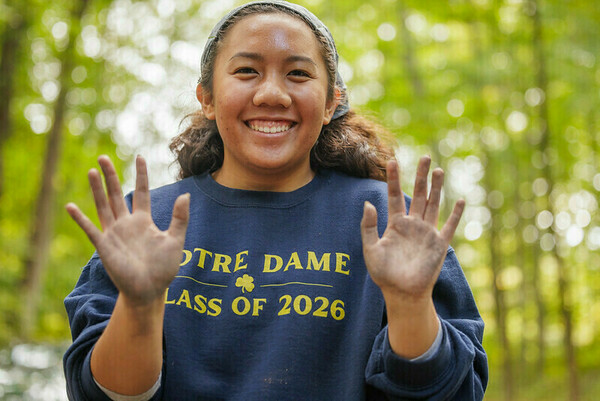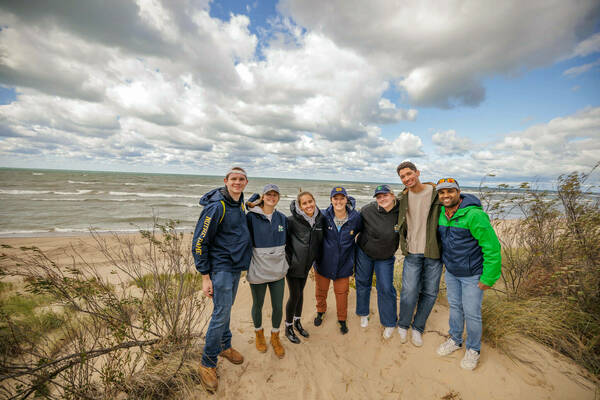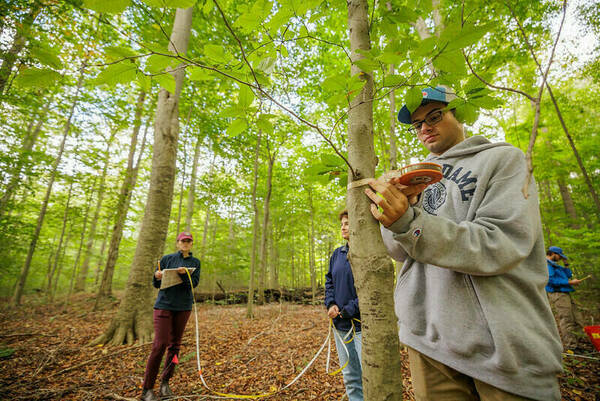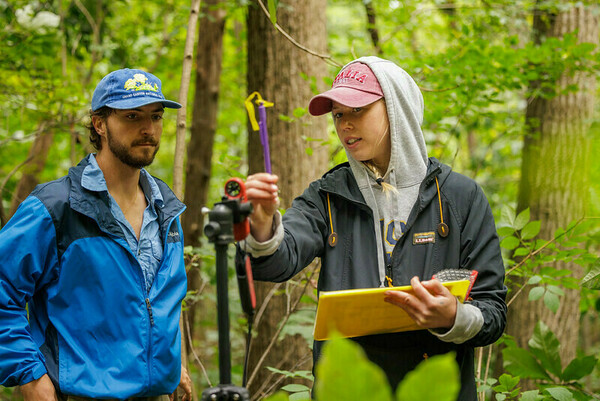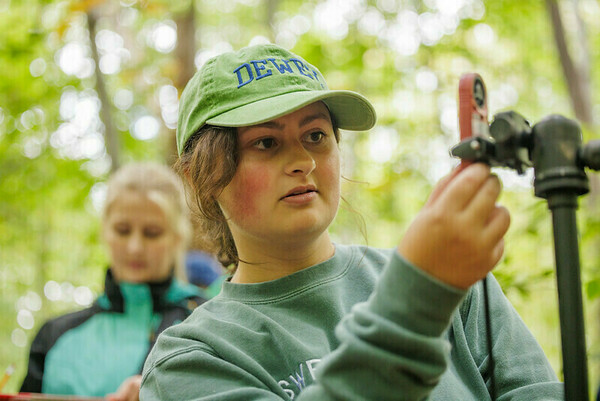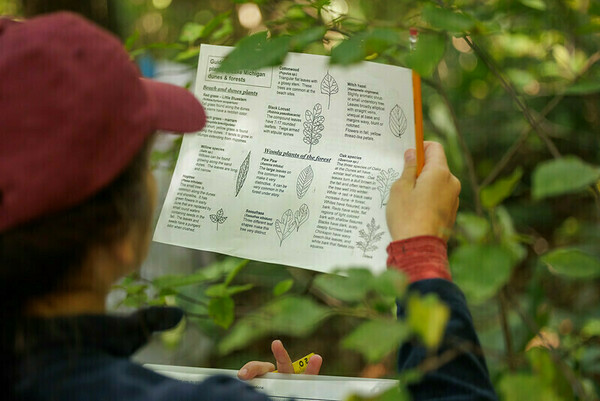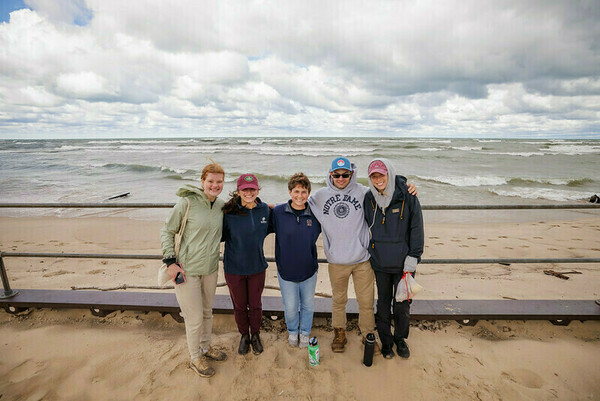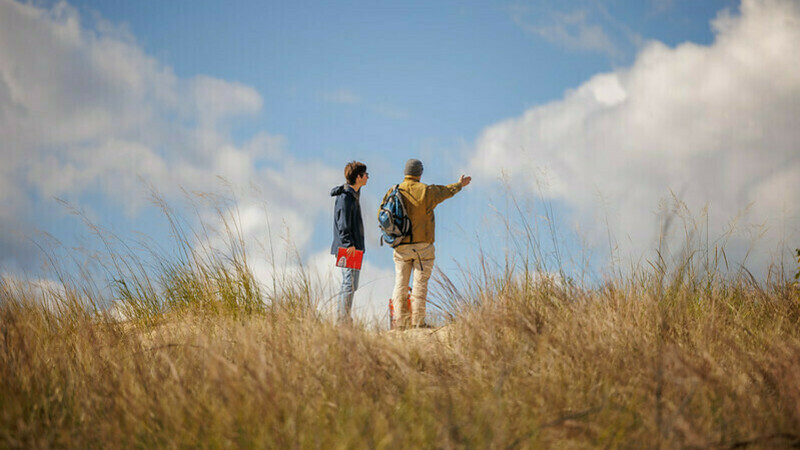
Unearthing Relationships
The many dimensions of an ecology field trip
Into the fall forest
A caravan of several vans descended upon Michigan’s Warren Woods State Park on a crisp October morning. As I and about twenty students and teaching assistants in Dominic Chaloner’s Practical Ecology Lab stepped out into the day, we were greeted by a sea of green: a cathedral-like expanse of beech trees, accented by scattered pops of red and yellow from nearby maples as a stiff northwesterly breeze kicked dry leaves across the road.
Chaloner, professor of the practice in the Department of Biological Sciences at the University of Notre Dame, and students planned to get their hands dirty and investigate the landscape in a way impossible in a sterile lab on campus. The goal for the morning was to study forest structure by determining the abundance of beech and maple trees: an undisturbed forest such as Warren Woods was expected to have mostly beeches.
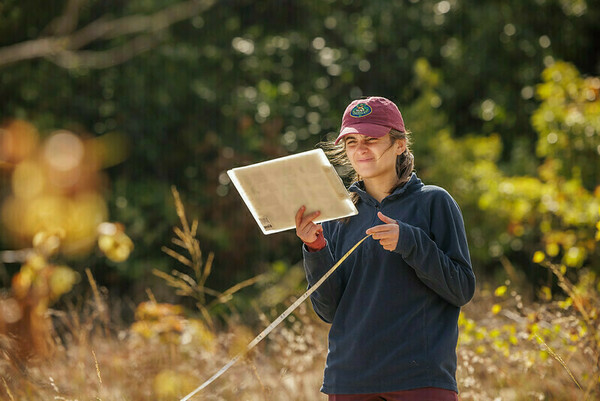
“Part of it is getting students to actually do science,” Chaloner said. They had indeed being doing a lot of science for the last few weeks: working productively in the lab, learning how to read and write scientific papers, and analyzing their data. The trees that they stood under would also be rigorously studied and written about in the coming weeks.
Yet there would be much more, beyond just those trees, that the students would come to appreciate on that chilly day . . .
All creatures great and small
The class’ first trip a month earlier had taken them to the farm of a lifelong Michigander and good friend of Chaloner’s, Bill Westrate, to learn about local ecology. Meanwhile, on this second trip, they were studying succession — the buildup of an ecological community from bare ground to a thriving ecosystem rich in species. Warren Woods, a characteristic beech-maple forest of southwest Michigan, is exactly how the land would have appeared in pre-European colonization times.
As that day’s survey began, groups of four to six students spread out, and the teaching assistants dispensed orders. Chaloner had already placed a 100-meter measuring tape that wiggled over shrubs and between snags, deep back into the woods, and the student groups took their places along it. The first task was to determine the species and diameter of each large tree within a five-meter radius of each student group. As the students unrolled their tape and placed their flags, their work chatter joined the background chorus of leaves rustling, wind whooshing, and the faint hum of passing cars.
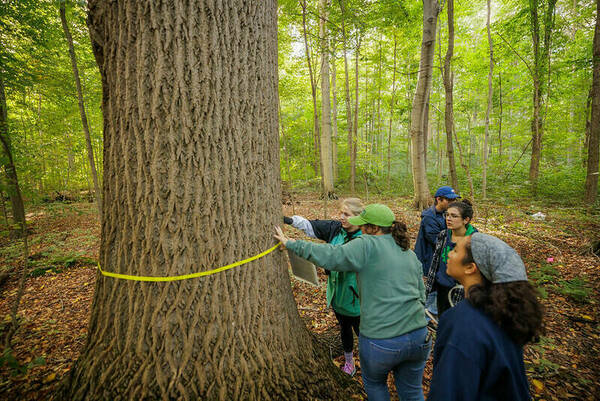
Sarah Skolozynski, one of the undergraduate teaching assistants, guided one group as they began to measure weather conditions such as temperature and light levels to see if those had any effect on what kind of trees grew. Another group, slightly closer to the road, hunched over a sieve with the other undergraduate teaching assistant, Quinn Mackay, preparing soil samples for analysis back in the lab. Chaloner poured the contents of a trowel into the sieve, while another student worked it through, her hands moving like she was kneading bread dough.
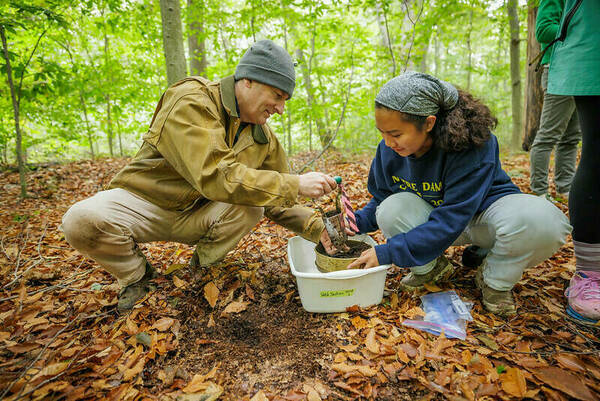
The soil that trickled through into a waiting plastic bag was a rich, chocolatey brown as the scattered leaves were filtered out.
One group’s work chatter stopped suddenly when someone noticed a unique little plant.
“Spicebush,” said Hanna Jewell, the graduate teaching assistant accompanying them. She plucked an emerald leaf off a shrub less than a foot high, crushed it, and brought it to each student’s nose. “Smells like Fruit Loops.”
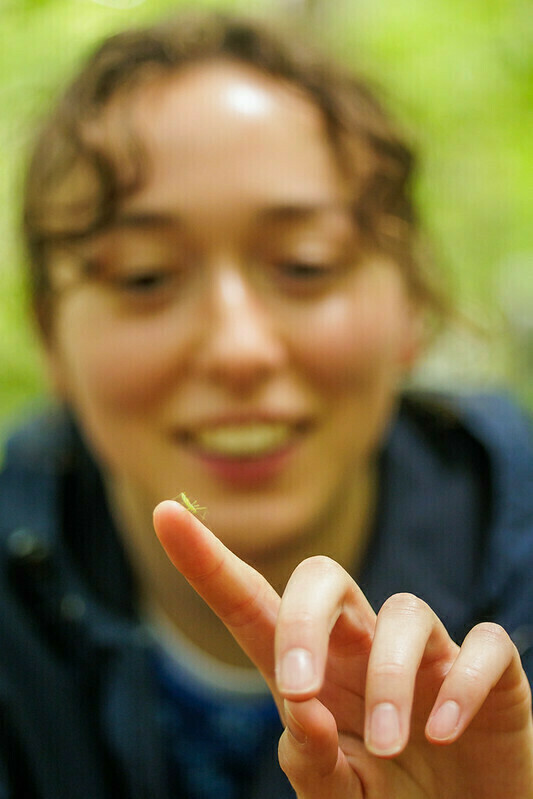
Soon after, another small creature interrupted a different group.
“Look, it’s an assassin bug,” said one student.
Despite its threatening name, the latest arrival to the forest party was about as non-threatening as it gets. Barely a half inch long, the light-green insect flailed its six legs as students passed it around. Perched on Skoloyznski’s finger, it became the subject of a charming photo.
It wasn’t just the small species, though, that happened to grab the students’ attention. Throughout the understory, tall trunks squatted like church columns rising high towards the green roof of the canopy. Each trunk that I could see was surrounded by a group of students calling out various numbers of diameters in centimeters.
Somebody called out with excitement. Their group had apparently discovered a true giant of the primeval forest, with a trunk bigger around than anything they’d seen so far. The tulip poplar that they were standing in front of, a characteristic Midwestern species with a deeply-grooved trunk and light, greenish-yellow and orange flowers in the spring (after it reaches at least 15 years old), was tall enough that no one could see the top even after fully tipping their heads back. After a brief moment of appreciation and a quick photo opportunity, their group returned to work.
There’s something to be gained from this recognition of both the small and large, noting the wonderfully-made uniqueness of the environment at each level. It’s an attitude best summed up by Pope Francis’ Laudato sí — fitting for a Catholic university — which describes this sort of contemplative action as an attitude of being fully present to everything, recognizing each thing as a gift to be appreciated. For at least one student, it was an eye-opening experience.
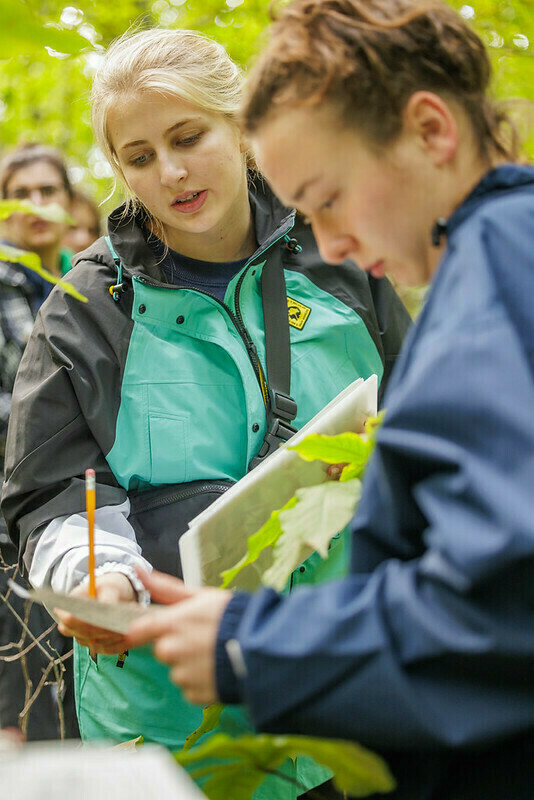
“Growing up in the Midwest, I’ve been to the forest a bunch of times, but now I’m coming back through the mindset of an ecologist,” said Josie Humbert, a sophomore environmental sciences and economics double major from outside of Chicago.
“Seeing the TAs and Professor Chaloner point out all these new species and realizing all the interactions has put things in a new perspective for me. So reimagining the places that seemed so stable to me in the past is a really cool thing.”
It’s also one of the reasons why Chaloner enjoys visiting here every year.
“My favorite part of these trips is just being out in nature — getting my dose of being outside,” he said. “It reconnects me with this location in a way not possible in an urban setting.”
“One motivation I’ve always had is to give ND students a sense of place,” he added. “Notre Dame is a completely artificial, human-created environment . . . so what I’m hoping is that these students get a real, deep sense of the environment that they’ve spent years not seeing. Many have no idea of the actual southwest Michigan, northwest Indiana ecosystem in which they live.
“Rarely do you get to see this stuff outside of campus, much less learning about it,” agreed Sophia Rockwell, an environmental sciences and global affairs major from Pennsylvania.
Noticing the unnoticed
Chaloner described that he is striving to get people to notice things that may not be so obvious immediately — the interplay of light and shadow, the small shrubs of the understory, or even some fanciful fungi growing on a rotting log.
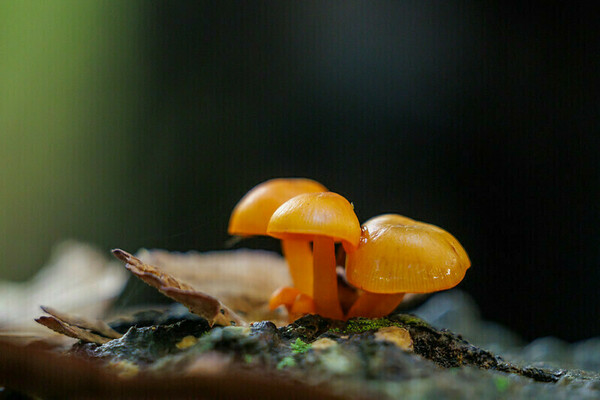
“It’s about paying attention to what they hear. What they see. What they smell,” he said.
Such a contemplative approach may fly in the face of our atomized, phones-in-the-face modern world, but it’s crucial to noticing how the environment is changing — and what we might be losing without even realizing it. That’s the perspective that Bill Westrate shares with each Notre Dame student who visits his southwest Michigan farm, about a 45-minute drive from the University.
He’s been noticing nature for decades.
“When I was four, one of the first farms my father bought was a piece of land that, to me, looked like the desert,” Westrate said. “It’d been severely damaged from the Dust Bowl. Dead cattle bones laying everywhere. I brought the bones home and made a little natural history museum under the card table. So I started really early with the nature stuff.”
Westrate later embraced his teaching side, which had led him to become the local expert on the environment. He began to study and collect wildlife: first plants, then insects, and then reptiles and mammals, as he recognized the complexity and interconnectedness of nature. Insects have been his primary interest, and he says they’ll engage him for the rest of his life.
“Over the last 40 years, I’ve documented about 1,400 species of butterflies and moths,” he said.
His observations, however, began to reveal some particularly insidious changes.
“When I was a kid in the 50s and 60s, that’s when the Dutch elm disease started to come through. Big beautiful elms died. Then in the late 70s and early 80s, I noticed, gee, all the amphibians are gone . . . Within a year, year and a half, half the number of species of frogs that were always here had disappeared. It used to be on a warm, rainy spring night, you’d have huge migrations of salamanders cross the road. All that disappeared. After that, the snakes started to disappear . . . and then in the 1990s, I started noticing a decline in the insects.”
Without the insects, the rest of the ecosystem began to collapse as well.
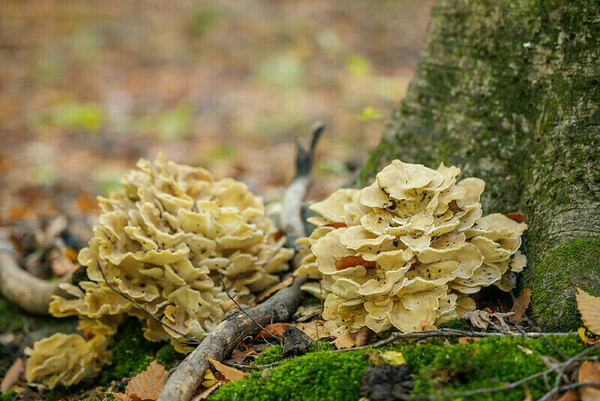
“There’s no barn swallows, no bats anymore,” he concluded. “I’m just watching a catastrophe here.”
Yet in Westrate’s eyes, the problem goes much deeper. He described how this ecological implosion went almost entirely unnoticed by most, and especially by younger people.
“They can’t appreciate what happened to the insects, since they don’t know anything about them,” he said.
And unfortunately, as Westrate would soon come to discover, their lack of environmental knowledge is often even more fundamental.
Around the time of his ecological crisis in the 1990s, he met George Craig, Notre Dame’s legendary entomology professor and mosquito researcher. Westrate and Craig bonded immediately over their shared interest, and Craig’s entomology classes began paying yearly visits to Westrate’s farm.
Yet, although the students collected a lot of insects, Westrate was shocked by what he saw from them.
“The first year, we split them up into three groups and each one of us took a group. We took a different route through the different environments. I realized at one point that a lot of the terms I was using; they had no idea what they were. One student picked up a walnut, he didn’t know what it was . . . ”
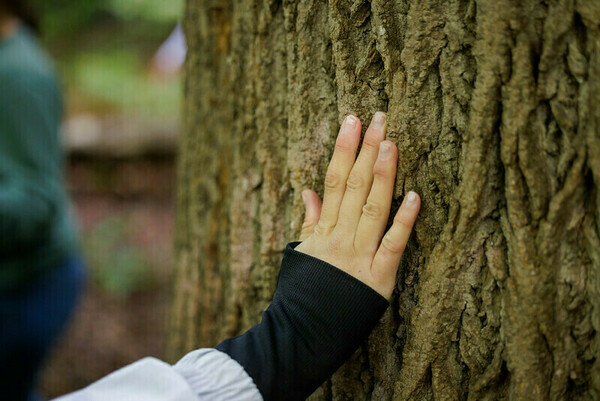
Westrate’s disbelief only increased from there.
“Then, I asked them what the crop over there was,” he continued. “None of them knew what it was. One guy says, ‘I don’t think it’s corn.’ ”
It was actually a field of soybeans.
With that, Westrate vowed to give his visitors the environmental exposure they hadn’t received. After Craig died in 1995, field trips continued with Jessica Hellmann, currently at the University of Minnesota; Jennifer Tank, Galla Professor of Biological Sciences; and now Chaloner, bringing a new batch of students to the farm each autumn. Despite the steady takeovers of the first whispers of the Internet through TikTok, Westrate has fought hard to keep his visitors engaged with the world beneath their feet.
“I wish I could interact more with them,” he said. “They almost never ask any questions. So the first thing I tell them is there are no stupid questions. If you don’t know something or want to know something, ask.”
He and Chaloner, for example, have worked to engage students by starting a scavenger hunt. Students would have to find various plants and animals on his property, such as the brilliant red leaves of the Virginia creeper, the hornlike fruits of the milkweed, or a walnut that the one student couldn’t identify in the 1990s.
Many students who I talked to have begun to pick up Westrate’s perspective on the environment through these experiences.
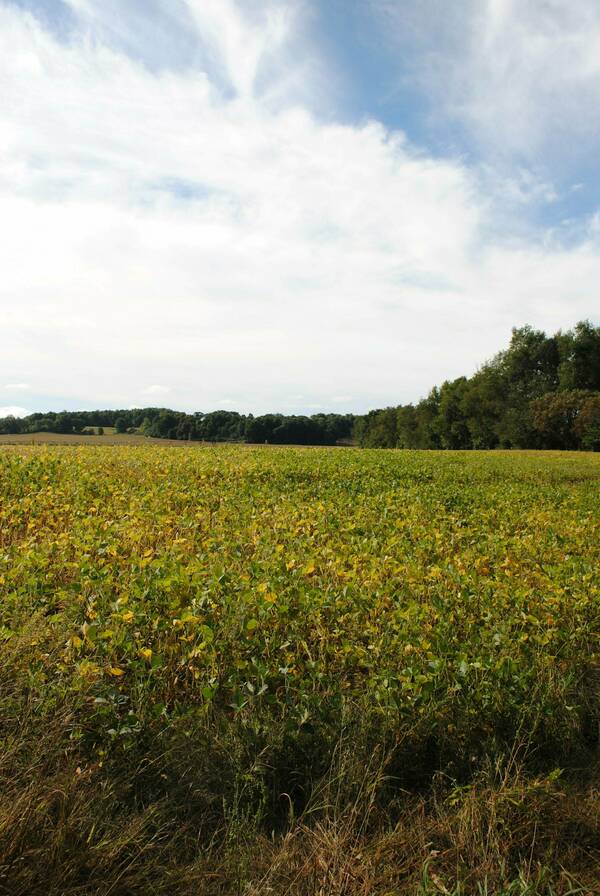
“The coolest thing [about these field trips] was to go to Bill’s property to learn and listen from him,” said Christopher Hill, a junior chemistry and environmental sciences double major from Connecticut. “Being able to talk to him about how things are changing and see how much more complex the ecosystem is than if you just took a quick glance at it.”
Gracie Speicher, a sophomore environmental sciences major from upstate New York, offered a similar perspective.
“People like Bill are really cool because they’re clearly just so enthusiastic about all this. You can definitely feed off that energy, and seeing them excited about it makes me excited to study this.”
It’s an excitement and receptiveness that Westrate lamented that he doesn’t see in people often anymore.
“I was at my daughter’s house around Christmas a few years ago,” he said. “Everyone, including my granddaughter, was hunched in front of the iPad. And I realized, at that point, they’re never going to realize the stuff I want to teach them. And that just broke my heart.”
Westrate’s insights hit upon one of the most important parts of this trip: the desire to foster connections between like-minded individuals. Students racing to turn over rocks and kick up leaves with their classmates, curious about the small yet beautiful things underneath their feet. A wise elder bursting with knowledge and the desire to share this knowledge with the world. Two old friends swapping stories.
Plenty of students noted that the communal interactions deepened their experience, both at Westrate’s farm and on the field trip that day.
“There’s a bonding experience in just going out to the middle of the woods with five other people and counting trees all day,” said Delina Quileza, a sophomore economics and environmental sciences supplementary major from Long Beach, California.
Serene attentiveness
Warren Dunes State Park, a billowy expanse of sand about ten minutes up the road from Warren Woods, served as the second stop on the trip.

Dunes such as these served as both the foundation for the forest that would become Warren Woods, and the birthplace of Henry Cowles’s theory of succession that Chaloner’s students were studying. Today’s students would repeat the same survey as they’d done in the woods to determine changes in conditions such as light, soil moisture, and temperature . . . and do a few other things, as well.
Without hesitation, the majority of Chaloner’s class poured out from the vans and skipped down the roller-coaster slope leading to the crashing waves and moody clouds of Lake Michigan, laughing all the way to the water’s edge.
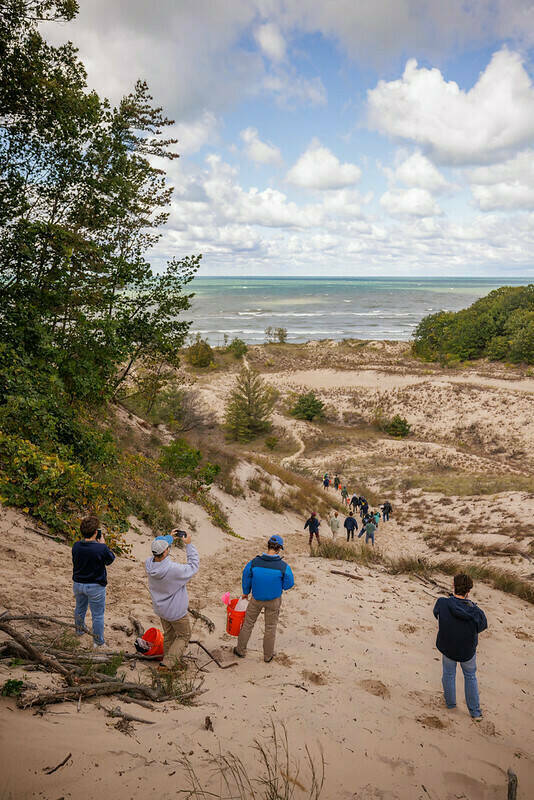
For a moment, it was just like being a carefree kid again — and for some, moments like these were their favorite part of the trip.
“I just like playing in the dirt,” said Quileza, reflecting on the day’s simple joys.
Moments like these are scarce. We’re constantly subscribed to a never-ending list of to-do’s and deadlines that often keep us from experiencing this kind of joy. Lunch at noon. Class at 2. Workout at 4. Grade papers at 5. It’s an attitude that often leads to the detriment of our mental health. Westrate has long noticed this, especially after reading Richard Louv’s seminal book Last Child in the Woods. The book’s “nature-deficit disorder,” he described, affects everyone, including each year of college students he hosts.
Indeed, these students (like many Americans) describe themselves as more stressed and burnt out than ever. Everyone is searching for answers. Tried-and-tested solutions, according to Harvard University, include meditation, physical activity, and social connection. However, as Chaloner’s students likely began to discover that Saturday, there may be yet another dimension.
Scientific research has begun promoting outdoor activity as yet another answer to many mental health problems currently gripping the nation — a fix that couldn’t come at a better time. According to the American Psychological Association, our anxiety is at an all-time high. From concerns about politics, to climate change, to final exams, everyone has something to be worried about.
Certainly, the spiral of social media and the ping of the Google Calendar alert don’t help. Yet during the field trip, everyone’s phone was firmly stuck with “No Service.” And everyone embraced it. Chaloner, who’s noticed this for years, described how the lack of technology intensifies the experience of the trip.
“In a situation where I don’t have anything to do or look at, what’s my natural tendency?” he asked rhetorically. “Open up my phone or laptop, rather than just sitting there and being present. In terms of teaching, I feel like this [trip] is the kind of thing where you can force students to stop using their phone, because it’s simply not possible.”
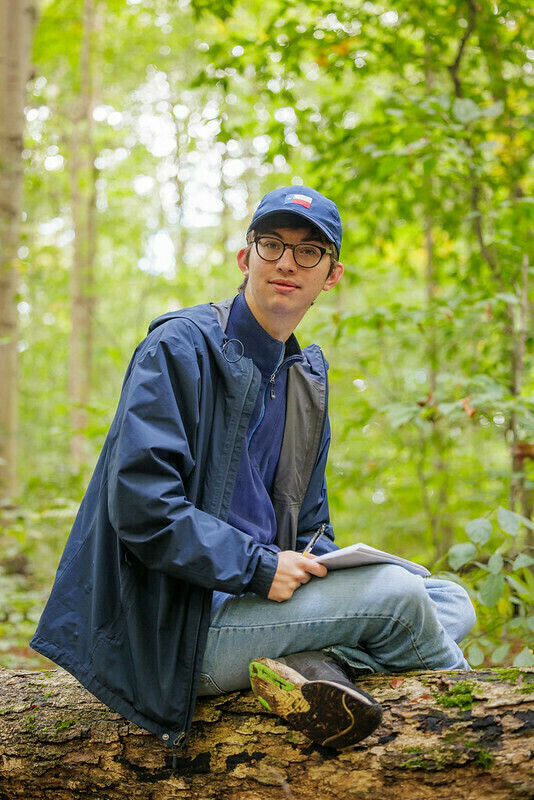
And “being present” may even inspire deep reflection. During a break in the action that morning, I had climbed to the top of a little hill nearby, sat, and absorbed what was going on around me.
The wind blowing through the trees above. The sassafras, pawpaws, beeches, and oaks rooted into the ground. The sun throwing bright rays through the canopy. And I thought to myself — when was the last time I’d contemplated nature this closely?
It’s a question that each one of us should be asking ourselves.
As we all scramble for answers to our burnout and anxiety, we may come to find that the best solution may only involve a quick step outside. No mindfulness trackers necessary. For those of us with busy schedules, these breaks don’t even have to be long. Even a 20-minute walk around campus or our neighborhood, without the phone, reaps incredible dividends as we slow down and get back in touch with an environment that moves at a much slower pace than we do. A river will deepen a canyon over thousands of human lifetimes, and we may plant a tree we may never sit under. It’s a centering and humbling perspective that recognizes our place in a universe that is much bigger than we are, that has gone on for eons and will continue for even longer.
Yet first, we must be willing to stop and see.
Story by John LeSage '24, environmental sciences major with a supplementary major in theology and a minor in earth sciences | Photos by Peter Ringenberg
View More Photos from the Field Trip
